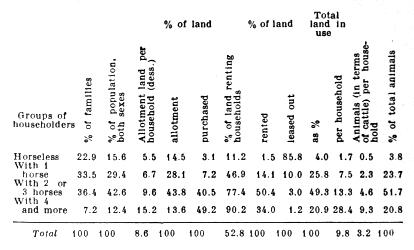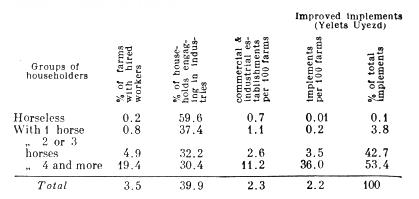
We have at our disposal two volumes of statistics, for the Yelets and Trubchevsk uyezds of this gubernia, which classify the peasant households according to the number of draught horses owned.[1]
Combining the two uyezds, we give the following joint data by groups.

From this we see that the general relations between the groups are the same as those we have seen earlier (the concentration of purchased and rented land in the hands of the well to-do, the transfer of the land to them from the poor peasants, etc.). Quite similar, too, are the relations between the groups as regards hired labour, “industries,” and “progressive trends” in farming.

And so, in Orel Gubernia also we see the differentiation of the peasantry into two directly opposite types: on the one hand, into a rural proletariat (abandonment of land and sale of labour-power), and, on the other, into a peasant bourgeoisie (purchase of land, renting on a considerable scale, especially of allotment land, improved methods of farming, hiring of regular farm labourers and day labourers, here omitted, and the combining of commercial and industrial enterprises with agriculture. The scale of farming by the peasants here, however, is generally much smaller than in the above-quoted cases; there are far fewer big crop growers, and the differentiation of the peasantry, to judge by these two uyezds, therefore seems weaker. We say “seems” on the following grounds: firstly, though we observe here that the “peasantry” turn more rapidly into a rural proletariat and produce hardly perceptible groups of rural bourgeois, we have, on the other hand, already seen examples of the reverse, where this latter pole of the countryside becomes particularly perceptible. Secondly, here the differentiation of the agricultural peasantry (we confine ourselves in this chapter to the agricultural peasantry) is obscured by the “industries,” the development of which is particularly extensive (40% of the families). And the “industrialists” here too include, besides a majority of wage-workers, a minority of merchants, buyers-up, entrepreneurs, proprietors, etc. Thirdly, here the differentiation of the peasantry is obscured because of the absence of data regarding the aspects of local agriculture that are most closely connected with the market. Commercial, market cultivation is not developed here to expand the crop areas to produce grain for sale but for the production of hemp. The largest number of commercial operations are bound up with this crop but the data of the tables given in the volume do not single out this particular aspect of agriculture among the various groups. “Hemp growing is the main source of the peasants’ income” (that is, money income. Returns for Trubchevsk Uyezd, p. 5 of descriptions of villages, and many others), “the peasants devote their attention mainly to the cultivation of hemp. . . . All the manure . . . is used on the hemp fields” (ibid., 87), everywhere loans are contracted “on security of hemp,” and debts are paid with hemp (ibid., passim). For the manuring of their hemp fields the well-to-do peasants buy manure from the poor (Returns for Orel Uyezd, Vol. VIII, Orel, 1895, pp. 91-105), hemp fields are leased out and rented in home and outside village communities (ibid., 260), and the processing of the hemp is done by part of the “industrial establishments” of whose concentration we have spoken. It is clear how incomplete is that picture of differentiation which gives no information about the main commercial product of local agriculture.[2]
[1] Statistical Returns for Orel Gubernia, Vol. II, Moscow, 1887. Yelets Uyezd, and Vol. III, Orel, 1887. Trubchevsk Uyezd. For the latter uyezd the data do not include those for the suburban village communities. We take joint data for the renting of land, combining the allotment and non-allotment rented land. We have determined the amount of leased land approximately, from the number of households leasing out the whole of their allotments. The figures obtained constitute the basis for determining the amount of land in use by each group (allotment + purchased land + rented land - land leased out).—Lenin
[2] The compiler of the returns for Orel Uyezd states (Table No.57) that the well-to-do peasants obtain nearly twice as much manure per head of cattle as do the poor (391 poods per head where there are 7.4 animals per household, as against 208 poods per head where there are 2.8 animals per household. And this conclusion was reached by classifying according to allotment, which obscures the real depth of differentiation). This is due to the fact that the poor are compelled to use straw and dung as fuel, to sell it, etc. Consequently, only the peasant bourgeoisie secure the “normal” quantity of manure (400 poods) per head of cattle. In this connection, too, Mr. V. V. might argue (as he does about the decline in horse possession) about “the restoration of the normal proportion” between the number of animals and the quantity of manure.—Lenin
| | |
| | | | | | |